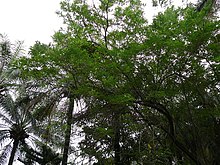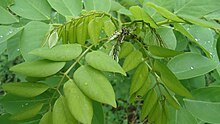Gliricidia sepium
| Gliricidia sepium | |
|---|---|

| |

| |
| Scientific classification | |
| Kingdom: | |
| (unranked): | |
| (unranked): | |
| (unranked): | |
| Order: | |
| Family: | |
| Genus: | |
| Species: | G. sepium
|
| Binomial name | |
| Gliricidia sepium | |
Gliricidia sepium, often simply referred to as Gliricidia (common names: Mata Ratón; Cacao de nance, Cachanance, it is commonly known as Piñon Cubano in the Dominican Republic; Madreado in Honduras; Kakawate in the Philippines; Madre Cacao or Madre de Cacao in the Philippines and Guatemala; and Madero negro in Nicaragua), is a medium size leguminous tree belonging to the family Fabaceae. It is considered as the second most important multi-purpose legume tree, surpassed only by Leucaena leucocephala.[1]
Description

Gliricidia sepium is a medium-sized tree and can grow to from 10 to 12 meters high. The bark is smooth and its color can range from a whitish gray to deep red-brown. It has composite leaves that can be 30 cm long. Each leaf is composed of leaflets that are about 2 to 7 cm long and 1 to 3 cm wide. The flowers are located on the end of branches that have no leaves. These flowers have a bright pink to lilac color that is tinged with white. A pale yellow spot is usually at the flower's base. The tree's fruit is a pod which is about 10 to 15 cm in length. It is green when unripe and becomes yellow-brown when it reaches maturity. The pod produces 4 to 10 round brown seeds . The tree grows well in acidic soils with a pH of 4.5-6.2. The tree is found on volcanic soils in its native range in Central America and Mexico. However, it can also grow on sandy, clay and limestone soils.[2][3]
Uses

The tree is used in many tropical and sub-tropical countries for various purposes such as live fencing, fodder, coffee shade, firewood,[4] green manure and rat poison.[5] Live fences can be grown from 1.5 m to 2.0 m stakes of Gliricidia sepium in just a month. Gliricidia can be intercropped with maize. Its effect is that of a potent fertilizer.[6][5]
G. sepium is also used for its medicinal and insect repellent properties. Farmers in Latin America often wash their livestock with a paste made of crushed G. sepium leaves to ward off torsalos. In the Philippines, the extract obtained from its leaves is used to remove external parasites.[2]
G. sepium is a fast-growing ruderal species that takes advantage of slash and burn practices in its native range. Its swift propagation has caused it to be considered as a weed in Jamaica.[3] Because it is easily propagated and grows quickly, it has also been suggested that this species may be planted to reduce topsoil erosion in the initial stages of reforesting denuded areas, an intermediate step to be taken before introducing species that take longer to grow.
According to World Agroforestry Centre, this species is becoming an important part of farming practices in Africa. G. sepium has a combination of desirable properties. Because it fixes nitrogen in the soil, it boosts crop yields significantly without the expense of chemical fertilizers. In addition, it tolerates being cut back to crop height year after year. The trees go into a dormant state when they are cut back, so the root system is not competing straight away for the nutrients, and the crop is free to become established. The trees only really start to come out of the dormant phase when the crop is already tall.[7]
References
- ^ Rani Batish, Daizy (2007). Ecological Basis of Agroforestry. CRC Press. p. 44. ISBN 1-4200-4327-7. Retrieved 2008-09-26.
- ^ a b "Gliricidia sepium". Treating Livestock with Medicinal Plants: Beneficial or Toxic?. Cornell University. Retrieved 2008-09-26.
- ^ a b "Gliricidia sepium". Tropical Forages. Australian Centre for International Agricultural Research. Retrieved 2008-09-26.
- ^ Lowe, Andrew; Stephen Harris; Paul Ashton (2004). Ecological Genetics. Blackwell Publishing. p. 154. ISBN 1-4051-0033-8. Retrieved 2008-09-26.
- ^ a b Elevitch, Craig R. (2004). The Overstory Book: Cultivating Connections with Trees. Permanent Agriculture Resources. p. 152. ISBN 0-9702544-3-1. Retrieved 2008-09-26.
- ^ http://www.worldagroforestry.org/downloads/publications/PDFs/JA06107.pdf
- ^ "Trees 'boost African crop yields and food security'". Planting trees to boost crop yields in Africa. BBC News. Retrieved 2011-10-16.
External links
- 2.2 "Gliricidia sepium - a Multipurpose Forage Tree Legume" in Forage Tree Legumes in Tropical Agriculture, Edited by Ross C. Gutteridge and H. Max Shelton. Tropical Grassland Society of Australia Inc.
- Gliricidia sepium (Jacq.) Steud. Purdue University.
- Gliricidia sepium in West African plants – A Photo Guide.
